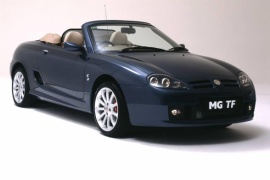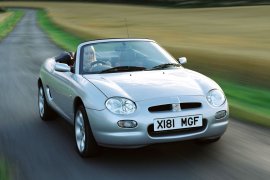MG F/ TF Models/Series Timeline, Specifications & Photos
First production year: 1995
Engines: Gasoline
Body style: Convertible (spider/spyder, cabrio/cabriolet, drop/open/soft top)
In 2002, the British carmaker Rover introduced a facelifted version for its little roadster TF, sold under the MG brand.
The classic British roadster used to feature front engines and rear-wheel drive. But the MG TF was not a classic vehicle. It was more like a modern interpretation of the roadster concept. It featured a mid-engine and rear-wheel drive system. After a troubling experience with BMW, MG tried to survive and built the little roadster with Toyota engines.
After six years on the market, the TF was refreshed. Its new headlights were covered with clear lenses and a sharper nose. Its turn-signals were moved from the bumper inside the headlamps. A smaller, two-slats grille replaced the previously used one that featured a vertical bar for the octagonal MG badge. In the rear, only a keen for details eye could have noticed a difference.
Inside, the British carmaker changed only a few details, such as the gear-knob, steering wheel, and a few materials used. It already had financial problems, and simply there was not enough money to do all the changes.
Under the hood, MG installed a choice of engines both from its production line and from Toyota. The latter was offered with a variable valve timing system that allowed a power increase to 160 hp.
The British brands are proud of producing the original roadster, and MG was one of the best car manufacturers in that segment, and in 1995 it reinvented the original design with the F model.
MG was well-known in automotive history. Over time, it lost its shine, but it continued to produce models that were very attractive to its customers. This F model was one of them because it was unique in the European market. Instead of placing the engine up front, it put it behind the cockpit.
The MG showed a new concept for the F's front fascia. It featured rounded headlights and oval-shaped blinkers and parking lights installed in the bumper. The split grille that sported the company's badge on a vertical slat in the middle resembled some older MG models but in a subtle way. From its profile, the roadster looked balanced, with the driver seating in the middle of the car since the cabin was moved forward to make room for the engine. Behind the doors, on the lower sides, the automaker installed air-intakes, which were not for decoration. Finally, at the back, the twin exhaust pipes poked through the bumper.
The two-seat cabin was cramped for full-grown adults and divided by the center console. The dashboard sported a twin-cockpit layout. In front of the driver, MG installed a small instrument cluster just big enough to sport a four-dials layout. On the center stack, the carmaker added two additional gauges above the stereo, while the controls for the HVAC system were placed at the bottom.
Behind the seats, MG installed a 1.8-liter engine carried over from Rover. It featured a variable valve timing system that made it very fuel efficient. Still, it was potent enough to rocket the little roadster from naught to 60 mph (0-97 kph) in less than seven seconds for the most powerful version.

